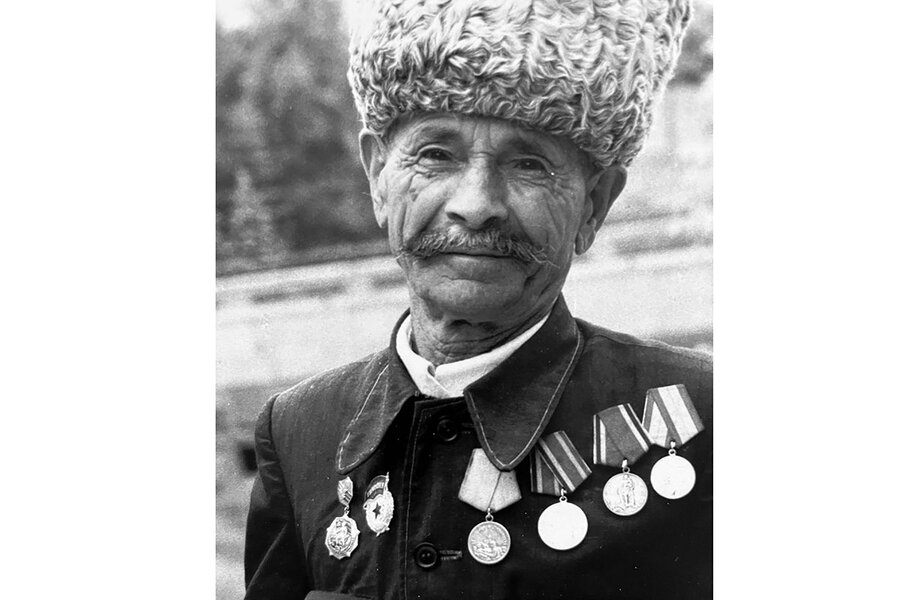A friendly face in a foreign place: My encounter with a Soviet soldier
Loading...
He was sitting on a low stone wall in a park in Moscow. He wore heavy black boots, tight black pants, a black jacket, and a sheepskin shapka on his head. He had military medals pinned to his chest. He sat calmly watching as people walked past. A few were walking alone. Some were talking to each other. Families were taking their children for a stroll.
His eyes were narrow, set in a weather-worn face featuring deep wrinkles across his brow, nose, and cheeks. His mouth, framed by a clipped mustache, seemed set in a subtle smile.
I watched him watching. I felt an urge to connect and walked toward the wall.
Why We Wrote This
Especially during times of heightened hostility and tension, we can find moments of connection and humanity that transcend borders, cultures, and even worldviews.
It was June 1983, and Russia was still part of the powerful Soviet Union. It was the middle of the Cold War. My wife, Peggy, and I were visiting four cities in the Soviet Union through Intourist, the government travel agency, and the only reasonable way of seeing life behind the Iron Curtain. We had visited what was then Leningrad, Kyiv, Odesa, and, finally, Moscow.
We saw several sites from the 1980 Olympics, which the United States and other countries had boycotted. Even three years later, it was a difficult subject. The boycott had cost Russia millions of dollars, but more importantly, it had cost the nation stature in the world. We had seen hundreds of propaganda posters showing the evil nature of the U.S. and its European allies. We had talked to a group of boys on the street who had said, “Mr. Reagan is a man of war. Mr. Andropov is a man of peace,” referring to the two nations’ leaders.
The influence of the Soviet Union extended beyond its border. The Berlin Wall still split that city, and the removal of that divider seemed unimaginable, even though it would happen six years later.
We had felt the tension of the times every day, and while we had been fascinated to see the Soviet Union, we were wearing down and looking forward to leaving. On our final day in Moscow, we had opted for a long walk, and that is when we saw the Russian man in the park.
He showed no surprise or concern as I walked toward him. His dark eyes met mine and we measured each other. Both my clothing and my curiosity would have told him I was American, but he did not move, nor take his eyes off me.
I had been taking photos in the park, so I still held my camera in my hand. When I moved within a few feet of him, I stopped. I moved my camera forward and then pointed to him. Without changing his eyes or his smile, he leaned forward and slowly rose to standing. He straightened and pulled his shoulders back, thrusting his chest and medals forward. It wasn’t a boastful pose, but more a motion of deep pride, of ingrained dignity.
I wished I could speak Russian. I sensed he had lived his life well, and I tried to imagine his story.
Did he have a family? What was his legacy? Had he chosen his place in life, or had he been forced, like so many others, to fight in wars like the current one in Ukraine? Was he happy in the present, or was he reliving moments from his past? What did he think of me, standing with my camera wanting to take pictures of him?
He spoke no English, so we faced each other in silence. I lifted my camera and took several photos of him. His expression never changed. His eyes were steady, his smile sustained.
When I finished, I lowered my camera.
“Spasiba,” I said. Thank you, one of the few phrases I had learned in Russian. His face changed into a full smile. I smiled back. Feeling I had bothered him enough, I turned, and we resumed our walk through the park.
After several strides, I glanced back. He had returned to his seat on the wall, again watching the people walking. I hadn’t been able to talk to him. We couldn’t share the essential stories that strangers often give to each other during these brief encounters, but I did read his face, felt his body language, and sensed a strong and memorable character.
It is interesting how we can, at times, feel a deep connection to another person that transcends geography, borders, culture, and language. Even though it was the Cold War and he was technically “the enemy,” I felt his humanity. It was an important lesson then, and is equally important today with the conflicts and tensions pressing our world. Forty years later, I still have images of him in my mind, of his peaceful pose in a time and place that history would show was anything but pleasant.





